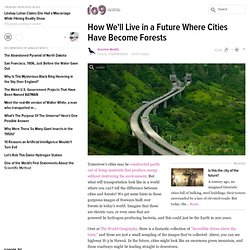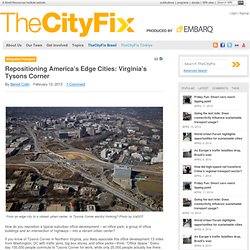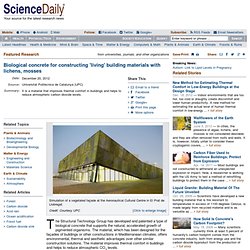

Cat-caf-is-coming-to-london-after-public-donates-100000-in-a-feline-frenzy-8507660. How We'll Live in a Future Where Cities Have Become Forests. Well, here's the thing, some parts of the world, or this country aren't green.

If by "green" we mean forests everywhere. California for example. A similar scene a California left to go natural again would probably mostly golden or Death Valley dry. San Diego and Los Angles couldn't be nearly as big as they are if it wasn't for the huge amount of water deverted from the entire Southwest to feed them. China's 'farmscrapers' are highrises that will generate their own food. Everything about this design indicates to me that this one won't happen either.

It looks like one of the traditional concepts of the "futuristic" building that's been around for over 100 years, but rarely gets made because it's so darned impractical. Plus it has all the hallmarks of something that looks good on paper but won't be built: Strange buildings that require unusual manufacturing processes that few builders will be capable of (and therefore can't build large numbers of at once)? Check. Alienating non-traditional designs with lots of wasted space and poor consideration of practical issues (such as sunlight, privacy, maintenance) that look good as abstract designs but aren't livable spaces?
A Cheerful Welcome To The Robots, Our Future Work Overlords. Repositioning America’s Edge Cities: Virginia’s Tysons Corner. From an edge city to a vibrant urban center.

Is Tysons Corner wishful thinking? Photo by VaDOT. How do you reposition a typical suburban office development – an office park, a group of office buildings and an intersection of highways – into a vibrant urban center? If you know of Tysons Corner in Northern Virginia, you likely associate this office development 13 miles from Washington, DC with traffic jams, big box stores, and office parks—think: “Office Space.” Every day 100,000 people commute to Tysons Corner for work, while only 20,000 people actually live there. Urban Light Causes Birds to Bloom Early. European Blackbird (turdus merula).

Image courtesy of IbajaUsap / shutterstock City lights at night make pretty views from space, but they’re not so good for sleeping. To overcome a messed up inner clock, many urban dwellers have learned to use light-blocking curtains or eye masks. But people aren’t the only ones who have to adjust to this unnatural illumination. Blackbirds, too, are exposed to this nighttime glow, and it actually makes them mature and moult sooner. Reproduction is a seasonal ritual for birds, hence the term mating season, and they take their cues from their environment. In a recent study, researchers set out to find out the effects of nighttime lights on male reproductive maturity in European blackbirds. A New Kind Of Concrete Gives Regular Buildings Living Walls. Buildings covered in vegetation aren’t just beautiful.

They also capture CO2 and provide insulation--you just have to deal with the fact that they need support structures that stress building walls and require lots of maintenance. Not so with the biological concrete developed by researchers at Barcelona’s Universitat Politècnica de Catalunya (UPC). The concrete requires no support structures because it actually supports fungi, moss, lichen, and microalgae growth on its own. UPC’s biological concrete is just regular concrete (carbonated concrete and concrete made with magnesium phosphate cement) with some tweaks of the material’s pH, roughness, and porosity. Biological concrete for constructing 'living' building materials with lichens, mosses.
The Structural Technology Group has developed and patented a type of biological concrete that supports the natural, accelerated growth of pigmented organisms.

The material, which has been designed for the façades of buildings or other constructions in Mediterranean climates, offers environmental, thermal and aesthetic advantages over other similar construction solutions. The material improves thermal comfort in buildings and helps to reduce atmospheric CO2 levels. How urban heat islands are making India hotter. It is bitterly cold in Delhi.

A bone-chilling wind has left temperatures below 3C (37F), the lowest since records began in 1969, and at least 100 homeless people are said to have died. But temperatures in the mega-city that is now home to an estimated 18 million people can be expected to rise to a sizzling 46C if there is a heatwave in May, and the city is often unbearably hot by the time the monsoon arrives at the end of June. Now, Indian government-backed research shows that both Delhi and India's biggest city, Mumbai, are becoming "urban heat islands", with significantly different climates to their surrounding rural areas.
Preliminary findings from the Delhi-based Energy and Resources Institute (Teri) show that temperatures in both cities have risen 2C-3C in only 15 years. The ongoing study, based on Nasa satellite readings, also shows the cities to be 5C-7C warmer than in the surrounding rural areas on summer nights. Artificial light at night advances avian reproductive physiology. + Author Affiliations e-mail: ddominoni@orn.mpg.de Abstract Artificial light at night is a rapidly increasing phenomenon and it is presumed to have global implications.

Light at night has been associated with health problems in humans as a consequence of altered biological rhythms. Effects on wild animals have been less investigated, but light at night has often been assumed to affect seasonal cycles of urban dwellers. 1. All over the world, urban areas are growing faster than any other land cover type [1]. Seasonal functions, such as reproduction, are thought to be under natural selection because optimal timing, i.e. when environmental conditions are most favourable, ensures best survival of both parents and offspring [13–15].